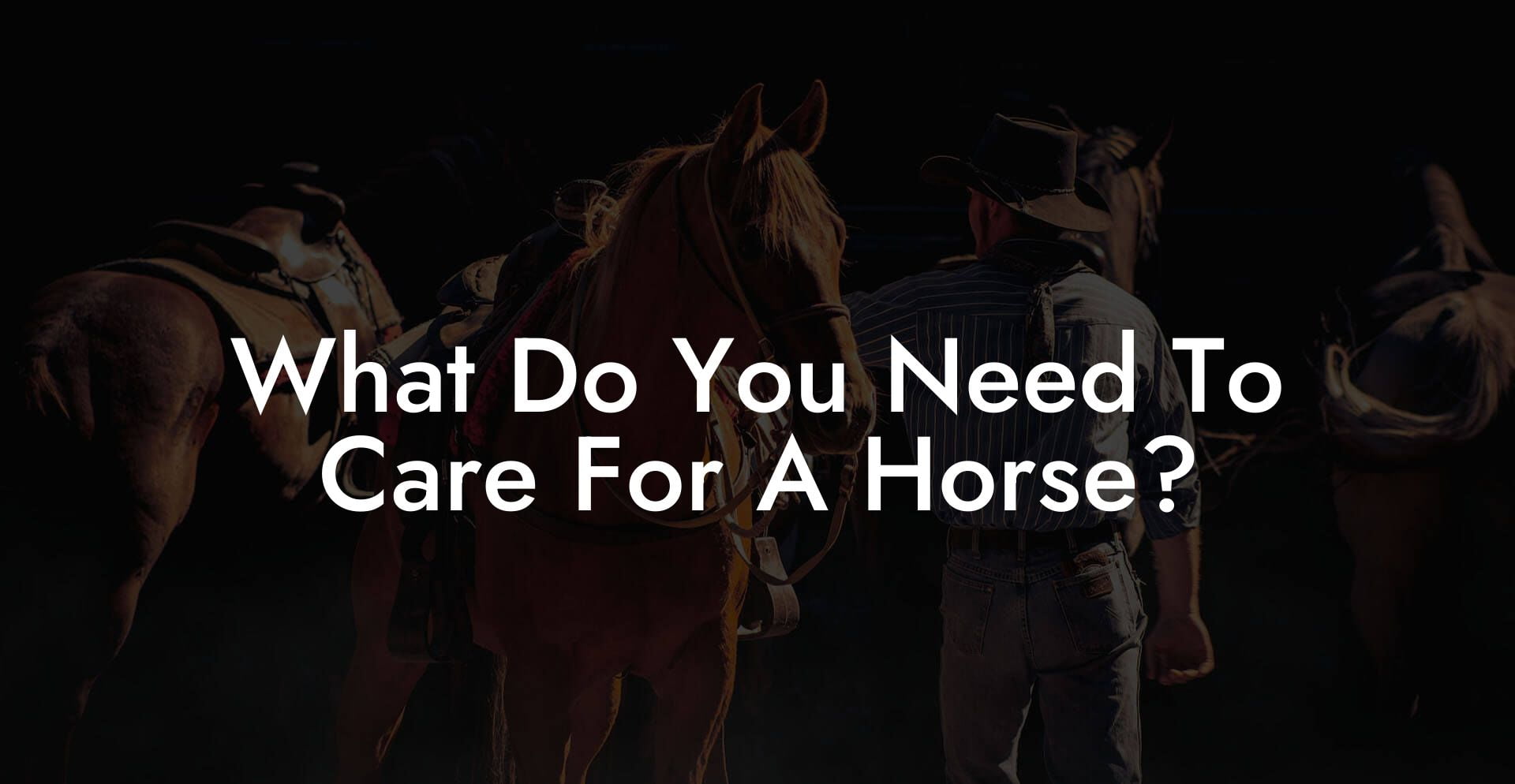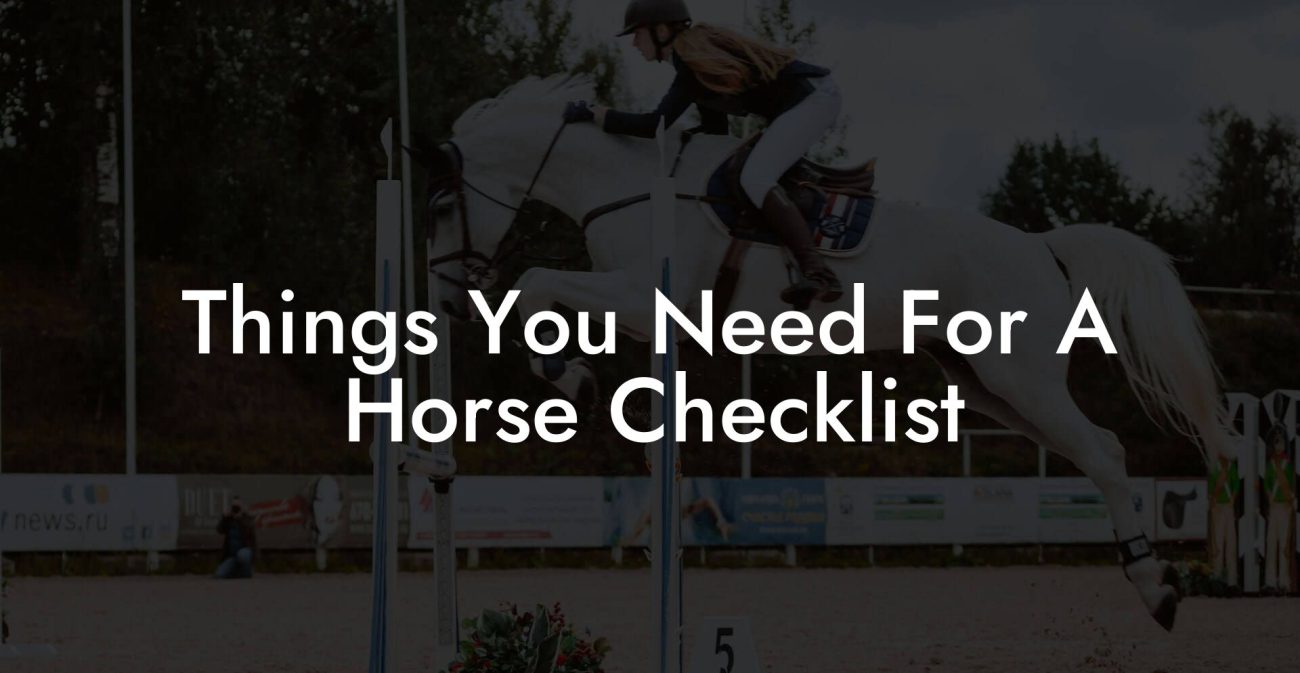Ever wondered what it truly takes to care for a horse beyond Insta-worthy stable setups and picturesque pastures? Caring for a horse isn’t just about snapping that perfect equine selfie—it’s a full-on lifestyle, a blend of art and science, and a commitment that goes way beyond the weekends. Whether you’re a seasoned rider or a newbie contemplating your equine dreams, this guide dives deep into the essentials of horse care: from nutrition and grooming to training, equipment, and building an online and offline community of support. So saddle up and get ready to embark on a journey that’s as informative as it is entertaining, with plenty of laughs, real-life stories, and expert tips to help you become the best horse parent you can be.
Quick Links to Useful Sections
- Understanding the Basics of Horse Care: It’s More Than Just Hay and Horseshoes
- Feeding and Nutrition: The Fuel That Keeps Your Equine Supercharged
- Essential Nutrients and Their Equine Benefits
- Modern Feeding Strategies and Tools
- Housing and Shelter: Building a Home Your Horse Will Love
- Stable Management and Pasture Setup
- Tech-Savvy Housing Options
- Grooming and Health: Keeping Your Horse Looking Fly and Feeling Fine
- Regular Grooming Practices
- Health Monitoring and Routine Check-Ups
- Exercise and Training: Strengthening the Bond Between You and Your Horse
- Developing a Training Routine That Works for Both of You
- Building a Bond Through Movement and Play
- Essential Equipment and Tools: Gear Up for Success
- Tack and Riding Gear
- Grooming and Stable Tools
- Modern Tech Tools
- Regular Veterinary Care: Safeguarding Your Horse’s Well-being
- Preventive Care and Routine Check-Ups
- Specialist Support and Modern Tools
- Building Your Equine Community: Resources and Community Support for Your Next Steps
- Online and Offline Equine Communities
- Professional Associations and Resource Hubs
- Integrative Case Studies: Real-Life Stories of Equine Care Success
- Case Study 1: From Neglected to Nurtured—Rehabilitating a Rescued Beauty
- Case Study 2: Balancing High-Energy and Calm—A Day in the Life of an Eventing Star
- Case Study 3: The Digital Revolution in Horse Care
- Creating Your Personalized Horse Care Plan: A Step-by-Step Guide
- Step 1: Comprehensive Assessment
- Step 2: Setting Clear, Achievable Goals
- Step 3: Integrate a Multifaceted Approach
- Step 4: Establish a Consistent Routine
- Step 5: Monitor, Evaluate, and Adapt
- FAQ: Your Most Pressing Horse Care Questions Answered
- Your Journey to Empowered, Confident Horse Care
Understanding the Basics of Horse Care: It’s More Than Just Hay and Horseshoes
Caring for a horse is a lot like maintaining a vintage sports car—or even a modern electric vehicle, if you will. It involves regular maintenance, attention to detail, and knowing what each unique component needs. At its core, horse care revolves around understanding the basics: proper nutrition, safe housing, regular exercise, and frequent health check-ups. But don’t be fooled—your horse is not just a set of muscles and mane; it’s an all-around living being with personality, quirks, and a few diva moments thrown in for good measure.
Before you dive headfirst into shopping for expensive tack or booking lessons at the local equestrian center, it’s essential to get the lay of the land. This means understanding everything from stable management and pasture rotation to daily grooming routines and feeding schedules. With a solid foundation in the basics, you’ll be ready to tackle more complex topics and even troubleshoot the occasional “this-horse-hates-its-feed” scenario.
In today’s fast-paced world, Gen-Z and millennial enthusiasts appreciate a blend of traditional wisdom and modern hacks. And guess what? You can use smartphone apps to track your horse’s health and nutrition, join online communities for support, and even order custom-made feed delivered straight to your barn door. The merging of technology and traditional pasture care has created a new era of equine wellbeing, ensuring that both you and your horse thrive—together.
Feeding and Nutrition: The Fuel That Keeps Your Equine Supercharged
When it comes to nutrition, horses aren’t all about the flashy gourmet diets you might see on influencer feeds. They need a balanced, nutrient-rich menu that fuels their daily activities and supports overall health. Think of your horse’s diet as a carefully curated mix of hay, grains, supplements, and the occasional treat that makes their eyes sparkle.
Essential Nutrients and Their Equine Benefits
Just like us humans (and our obsession with avocado toast), horses thrive on a balanced diet. A quality forage—usually in the form of hay or pasture grass—is the cornerstone of their diet. This provides the roughage necessary for healthy digestion. But there’s more to the story:
- Carbohydrates: The primary energy source for your horse. Carbs in the form of grains should be given in moderation, especially if your horse leads a more sedentary lifestyle.
- Proteins: Essential for repairing tissues and supporting muscle recovery, especially after a hard day’s ride or training session. Look for sources like soybean meal or alfalfa.
- Fats: A precious energy source, particularly important during colder months. Omega-3 fatty acids, found in flaxseed, are excellent for maintaining a shiny coat and overall health.
- Vitamins and Minerals: These micronutrients—such as calcium, magnesium, and vitamins A, D, and E—are crucial for bone development, immune function, and overall vitality. Supplementing with vitamin E and selenium, in particular, can yield noticeable improvements in your horse’s performance and health.
Modern Feeding Strategies and Tools
In our high-tech era, equine nutrition has also embraced technology. Gone are the days when feeding schedules meant scribbled notes on a fridge. Today, smart feeders and mobile apps let you keep track of portion sizes, feeding times, and even your horse’s weight changes—in real time!
Moreover, many modern horse owners incorporate rotational grazing practices that not only enhance pasture quality but also help reduce parasitic load. This method mimics a natural grazing pattern and keeps your horse’s digestive system in top form.
Remember, every horse is unique, and dietary needs may vary depending on age, activity level, and overall health. Regular consultations with a veterinarian or an equine nutritionist can help tailor a program that perfectly fits your horse’s lifestyle.
Housing and Shelter: Building a Home Your Horse Will Love
A horse’s home is its sanctuary. Whether your horse enjoys the wide-open space of a pasture or the structured environment of a barn, providing a safe, comfortable shelter is non-negotiable. After all, even the coolest animal needs a cozy spot after a long day of galloping or grazing.
Stable Management and Pasture Setup
Let’s break down the essentials of housing:
- Stalls and Barns: Your horse’s living quarters should be clean, well-ventilated, and spacious enough to allow free movement. Regular mucking out, proper drainage, and fresh bedding (think straw or shavings) are daily musts.
- Pasture Rotation and Fencing: Fresh, green pasture is like a five-star restaurant for horses. Rotational grazing not only promotes healthy grass growth but also prevents the build-up of pests and parasites. Secure fencing ensures your horse stays safe while enjoying the outdoors.
- Shelter in the Elements: Horses need protection from extreme weather. Whether it’s a run-in shed in the pasture or a well-insulated barn, having a dry, windproof area is essential during storms or chilly nights.
Tech-Savvy Housing Options
The great thing about modern equine management is how technology has elevated even traditional aspects of horse care. Smart barn systems now incorporate temperature control, automated feeding systems, and even surveillance cameras to monitor your horse’s day-to-day activities. This marriage between old-school care and new-school tech ensures that your equine friend always feels at home—whether you’re around or not.
When designing or upgrading your stable and pastures, be sure to consider factors like local climate, terrain, and your horse’s behavior. A well-planned housing setup promotes not only physical health but also mental wellbeing for your loyal companion.
Grooming and Health: Keeping Your Horse Looking Fly and Feeling Fine
Grooming is more than a beauty routine—it’s an essential aspect of maintaining your horse’s overall health. Think of it as a daily spa day for your equine friend, where comfort meets care (with a dash of style!).
Regular Grooming Practices
A consistent grooming routine can do wonders for your horse, and it’s a great way to bond. Here’s a cheat sheet of what every horse owner should know:
- Brushing: Use a variety of brushes to remove dust, sweat, and loose hair, while also stimulating the skin and increasing blood circulation. A slicker brush, curry comb, and soft-bristle brush are staples.
- Hoof Care: Regular cleaning and inspections are essential to prevent infections and injuries. A hoof pick, soft brush, and periodic farrier visits ensure your horse’s hooves remain healthy and strong.
- Bathing: Not every day is bath day, but occasional washes using equine-safe shampoos help maintain a shiny coat. Just be sure not to overdo it, as too much water can strip essential oils from the skin.
- Mane and Tail Care: Detangling and gentle washing with appropriate conditioners keep manes and tails looking luscious and free from knots. It’s all about that effortless equine chic.
Health Monitoring and Routine Check-Ups
Just like you might get a yearly check-up, your horse needs regular vet visits to monitor its health. Vaccinations, deworming schedules, dental care, and body condition scoring are key components of preventive health. Even minor irritations or injuries should be addressed promptly to prevent more significant problems down the road.
Many modern vet practices now offer mobile services, so you can have an expert check on your horse without ever leaving the barn. And let’s not forget technology—fitness trackers for horses can monitor activity levels and even sleep patterns, giving you insights into your horse’s daily performance.
By keeping a close eye on your horse’s grooming and health needs, you not only enhance its quality of life but also forge a deeper bond built on trust, care, and mutual respect.
Exercise and Training: Strengthening the Bond Between You and Your Horse
Physical activity is the heartbeat of horse care. Regular exercise ensures that your horse maintains muscle tone, stays mentally stimulated, and—most importantly—enjoys life to the fullest. Whether it’s a leisurely trail ride, an intense training session, or simply letting your horse graze in an open field, exercise is a non-negotiable part of a well-rounded equine care routine.
Developing a Training Routine That Works for Both of You
The world of horse training has evolved from strict, military-style methods to more empathetic, trust-based approaches that contemporary riders swear by. Modern training programs, often inspired by natural horsemanship, emphasize clear communication, mutual respect, and fun. Using positive reinforcement, clicker training, and even playful games can transform training sessions into a truly rewarding experience.
Warm-Ups and Cool-Downs: Just like athletes, horses benefit immensely from a proper warm-up and cool-down routine. Gentle stretching, walking, and light trotting prepare the muscles for more demanding exercises while preventing injuries and soreness.
Variety is the Spice of Life: Incorporate different activities into your horse’s routine—from arena lessons and trail rides to ground work and obstacle courses. Not only does this keep your horse physically fit, but it also staves off boredom and fosters mental agility.
Building a Bond Through Movement and Play
The act of training goes beyond physical exercise—it’s about building a connection. Spending quality time working closely with your horse creates trust, lowers stress levels, and even enhances communication outside the arena. So whether you’re tackling advanced dressage maneuvers or just playing a game of “follow the leader” around the barn, each moment is an opportunity to deepen your bond.
For the Gen-Z and millennial crowd, social media may be all about sharing epic riding clips and creative training milestones. But don’t forget, each reel and snap tells a story of dedication, perseverance, and the sheer joy that comes from working in tandem with your four-legged partner.
Essential Equipment and Tools: Gear Up for Success
Let’s be real—no great equine story is complete without a flashy set of tack, equipment, and a toolbox of maintenance tools. From saddles to bridles, grooming kits to horse blankets, having the right equipment can make all the difference in your horse care routine. Think of it as curating your very own equestrian wardrobe, where each piece plays a special role in the overall ensemble.
Tack and Riding Gear
A well-fitted saddle is not only a style statement—it is critical to ensuring comfort and safety for both you and your horse. The key items include:
- Saddles: Different disciplines require different types of saddles, so choose the one that best suits your riding style and your horse's conformation. A comfortable fit prevents chafing and injury.
- Bridles and Bits: These are crucial for effective communication with your horse. From snaffle bits to more advanced control systems, always ensure the gear is adjusted correctly.
- Stirrups and Reins: Properly sized and comfortable stirrups, along with reins that are well-adjusted, enhance both your stability and your horse’s gait.
Grooming and Stable Tools
Beyond the basics of tack, a reliable set of grooming tools is indispensable. Invest in high-quality brushes, hoof picks, and even specialized cleaning tools for tack maintenance. Having a well-stocked grooming kit ensures you’re always ready to give your horse the VIP treatment it deserves.
Modern Tech Tools
In an age where everything from coffee orders to ride-sharing can be managed via an app, why not harness technology for your equine care? From fitness trackers monitoring your horse’s activity levels to automated waterers and smart stable systems, modern equipment can make your life easier by reducing the manual labor of daily chores.
Whether it’s upgrading your tack or investing in new-age stable monitoring systems, always choose equipment that is well-reviewed and fits both your budget and your horse’s needs.
Regular Veterinary Care: Safeguarding Your Horse’s Well-being
Just like you schedule your annual physical, your horse needs regular check-ups to ensure it stays healthy and injury-free. Veterinary care is a crucial pillar of overall horse care. It encompasses everything from routine vaccinations and preventive dental care to managing unexpected injuries and illnesses.
Preventive Care and Routine Check-Ups
Preventive care is the bedrock of effective horse management. Regular veterinary examinations can catch potential issues before they escalate into serious problems. Here’s what to keep on your checklist:
- Vaccinations: Stay up-to-date with your horse’s vaccination schedule, which protects it from common infectious diseases like tetanus, rabies, and equine influenza.
- Deworming: A regular deworming program is essential to prevent parasitic infections that could compromise your horse’s digestive health.
- Dental Care: Dental check-ups help prevent tooth decay and ensure your horse chews efficiently, which is critical for proper digestion.
- Emergency Care: Beyond routine maintenance, establish an emergency plan with a trusted veterinarian for cases of colic, lameness, or other urgent health issues.
Specialist Support and Modern Tools
With advancements in veterinary medicine, many practices now incorporate modern diagnostic tools such as ultrasounds, digital radiography, and even lab analysis to ensure that every aspect of your horse’s health is meticulously monitored. Don’t hesitate to consult with specialists if your horse has any persistent issues.
Ultimately, regular veterinary care not only protects your investment but also ensures that your horse lives its best, healthiest life possible.
Building Your Equine Community: Resources and Community Support for Your Next Steps
Embarking on your horse care journey can feel overwhelming at times, but the beauty of the equestrian world is its strong sense of community. In today’s digital age, there are countless resources available at your fingertips—from forums and social media groups to local clubs, events, and even virtual clinics.
Online and Offline Equine Communities
You don’t have to go it alone. Whether you’re sharing tips on maintaining your horse’s grooming kit on Reddit or attending a local horse show, connecting with other horse enthusiasts can provide valuable insights and moral support. Many communities also offer DIY workshops, training clinics, and peer-to-peer mentorship that help you refine your skills and resolve challenges.
Moreover, influencers and bloggers in the equine space often share personal stories and innovative hacks that blend traditional wisdom with modern technology. From Instagram reels showcasing creative tricks to YouTube tutorials on stable management, these platforms can be great resources to keep you motivated and informed.
Professional Associations and Resource Hubs
Beyond informal communities, numerous professional associations offer certifications, workshops, and detailed guides on all aspects of horse care. Organizations dedicated to equine nutrition, stable management, and veterinary science often publish the latest research and practical advice—ensuring you have access to evidence-based strategies.
Additionally, many equine supply companies host blogs, webinars, and live Q&A sessions that address common challenges and innovative solutions in horse care. These resources make it easier than ever to tailor a care plan that fits your needs and fosters continuous learning.
Integrative Case Studies: Real-Life Stories of Equine Care Success
Sometimes the best way to learn is by diving into real-life success stories. Let’s take a look at a few inspiring case studies that highlight the transformative power of a well-rounded horse care routine:
Case Study 1: From Neglected to Nurtured—Rehabilitating a Rescued Beauty
When Bella—a once-neglected rescue horse with a scarred past—was taken in by a dedicated young rider, the transformation was nothing short of miraculous. The new owner implemented a comprehensive care plan that featured balanced nutrition, consistent grooming sessions, regular veterinarian check-ups, and a personalized exercise program. Over time, Bella’s coat regained its luster, her gait became more confident, and an unbreakable bond formed between them. Bella’s journey is a testament to what love, care, and a holistic approach to horse maintenance can achieve.
Case Study 2: Balancing High-Energy and Calm—A Day in the Life of an Eventing Star
Meet Turbo, a sprightly eventing horse known for his explosive energy on the show ring. Turbo’s owner developed a training routine that combined intense exercise sessions with ample recovery periods and advanced nutritional support. This harmonious balance allowed Turbo to excel at competitions while maintaining peak health. The integration of modern tracking tools to monitor Turbo’s recovery and rest levels ensured that he was always competition-ready and never overworked.
Case Study 3: The Digital Revolution in Horse Care
In a world where technology meets tradition, Olivia—a tech-savvy millennial—blended her passion for horses with modern digital tools. By using equine health apps, automated stable systems, and online communities, she transformed her small barn into a smart stable. This forward-thinking approach allowed her to monitor everything from feed schedules to exercise routines with precision. As a result, her horse, Max, enjoyed a level of care that perfectly balanced old-school wisdom and new-school innovation.
These case studies illustrate that regardless of the starting point, with dedication, the right resources, and a commitment to comprehensive care, every story can have a happy ending.
Creating Your Personalized Horse Care Plan: A Step-by-Step Guide
Crafting a customized care plan for your horse is the ultimate way to ensure long-term health and happiness. Just like any successful project, planning is key. Here’s how you can design a program that’s as unique as your equine friend:
Step 1: Comprehensive Assessment
Start by thoroughly evaluating your current setup. This includes your horse’s physical health, nutritional habits, stable conditions, and daily routines. Document everything from activity levels to behavior quirks. Consulting with equine professionals—a trusted veterinarian, an experienced stable manager, or even online experts—can provide invaluable insights into what needs improvement.
Step 2: Setting Clear, Achievable Goals
Next, define what success looks like for you and your horse. Whether it’s building stamina for long rides, optimizing nutrition for a shiny coat, or simply ensuring your horse feels loved and secure, setting realistic goals will help you stay focused. Think of these goals as milestones in your ongoing equine care journey.
Step 3: Integrate a Multifaceted Approach
Your personalized plan should be a blend of various care strategies, such as:
- Nutrition Management: Adjust feeding schedules and supplies based on professional advice and modern monitoring tools.
- Regular Exercise and Training: Develop a routine that balances structured training with free-flowing play and social time.
- Grooming and Health Checks: Create a daily or weekly schedule for grooming, stable cleaning, and health inspections.
- Equipment and Tech Upgrades: Invest in the best-suited tack, grooming kits, and even tech-driven health monitors.
- Community and Professional Support: Stay connected with local clubs, online forums, and expert network groups to continuously adapt and improve your practices.
Step 4: Establish a Consistent Routine
Consistency is key in horse care, just as it is in any successful endeavor. Leverage digital calendars and apps to schedule daily tasks, weekly cleaning, feeding times, exercise routines, and regular vet visits. Remember, every little step counts in creating a nurturing bond and a healthy environment.
Step 5: Monitor, Evaluate, and Adapt
Finally, keep a journal or use digital tools to track progress, note changes in behavior, and document improvements. Regularly reviewing your plan with professionals ensures that your strategy evolves with your horse’s growing needs. This not only helps in celebrating successes but also in adjusting methods when challenges arise.
With your personalized horse care plan in place, you’re not just navigating the day-to-day routines—you’re setting the stage for a lasting partnership rooted in trust, health, and a shared love for the journey ahead.
FAQ: Your Most Pressing Horse Care Questions Answered
Here’s a roundup of frequently asked questions that many horse enthusiasts have, complete with expert insights to guide you in providing the best care for your equine companion.
1. What are the basic daily needs to care for a horse?
Every horse needs clean water, a balanced diet (primarily good quality hay and appropriate grains), ample space to move in a safe, clean environment, regular grooming, and routine veterinary check-ups.
2. How often should I groom my horse?
Daily grooming is ideal, especially brushing and hoof cleaning. However, a more thorough grooming session including mane and tail care should be scheduled weekly.
3. What types of feed should I provide my horse?
High-quality forage like hay or access to pasture is essential. Supplement with grains and protein sources as needed, and consider additional vitamins and minerals based on your vet’s advice.
4. How often should my horse have a veterinary check-up?
At least once a year for routine examinations, but more frequent visits are necessary if there are specific health issues, signs of illness, or during seasonal health changes.
5. Can I use modern technology to monitor my horse’s health?
Absolutely! Many owners now use apps, wearable fitness trackers, and automated stable systems to monitor feeding, exercise, and overall health.
6. What should a proper stable setup include?
A clean, well-ventilated space with safe fencing, proper drainage, secure shelter from the elements, and scheduling for regular cleaning is vital for your horse’s home.
7. How do I know if my horse is receiving proper nutrition?
Monitoring body condition, regular vet check-ups, and sometimes lab analyses of nutrient levels can help ensure your horse’s diet meets its energetic needs.
8. What are some common mistakes in horse care?
Neglecting routine grooming, inconsistent feeding schedules, insufficient exercise, and improper stable management are common pitfalls. Regular education and consultation can help avoid these issues.
9. Is it expensive to care for a horse?
Horse care can be an investment, but budgeting and using community resources, along with modern efficiencies, can help manage expenses while ensuring quality care.
10. How do I start if I’m new to horse ownership?
Start by educating yourself with credible resources, connecting with local equestrian communities, consulting professionals, and gradually building a care routine that suits both your and your horse’s needs.
Your Journey to Empowered, Confident Horse Care
Caring for a horse is an adventure—a blend of art, science, and pure heart. With each new day, whether you’re feeding, grooming, training, or simply sharing a quiet moment with your equine companion under a starry sky, you’re part of a rich tradition that spans centuries.
Every brushing stroke, every measured feed, and every training session builds not only a healthier horse but also a deeper bond between you two. Embrace the learning curves, laugh off the mishaps, and always remain curious. Your journey in horse care is a dynamic process of growth, empathy, and resilience—an endless adventure that continually rewards you with trust, beauty, and unforgettable moments.
Remember, the art of horse care is not a destination but a way of life. Embrace technology, lean into community, and honor traditional practices as you pave your own path. Armed with the right knowledge and tools, you’re now ready to create a thriving sanctuary for your horse where both lives flourish in harmony.
So, dust off your boots, grab your favorite gear, and step into the captivating world of horse care with confidence and joy. Let this comprehensive guide be your trusted companion as you build a lasting legacy of love, care, and quality equine living—one hoofbeat at a time.













